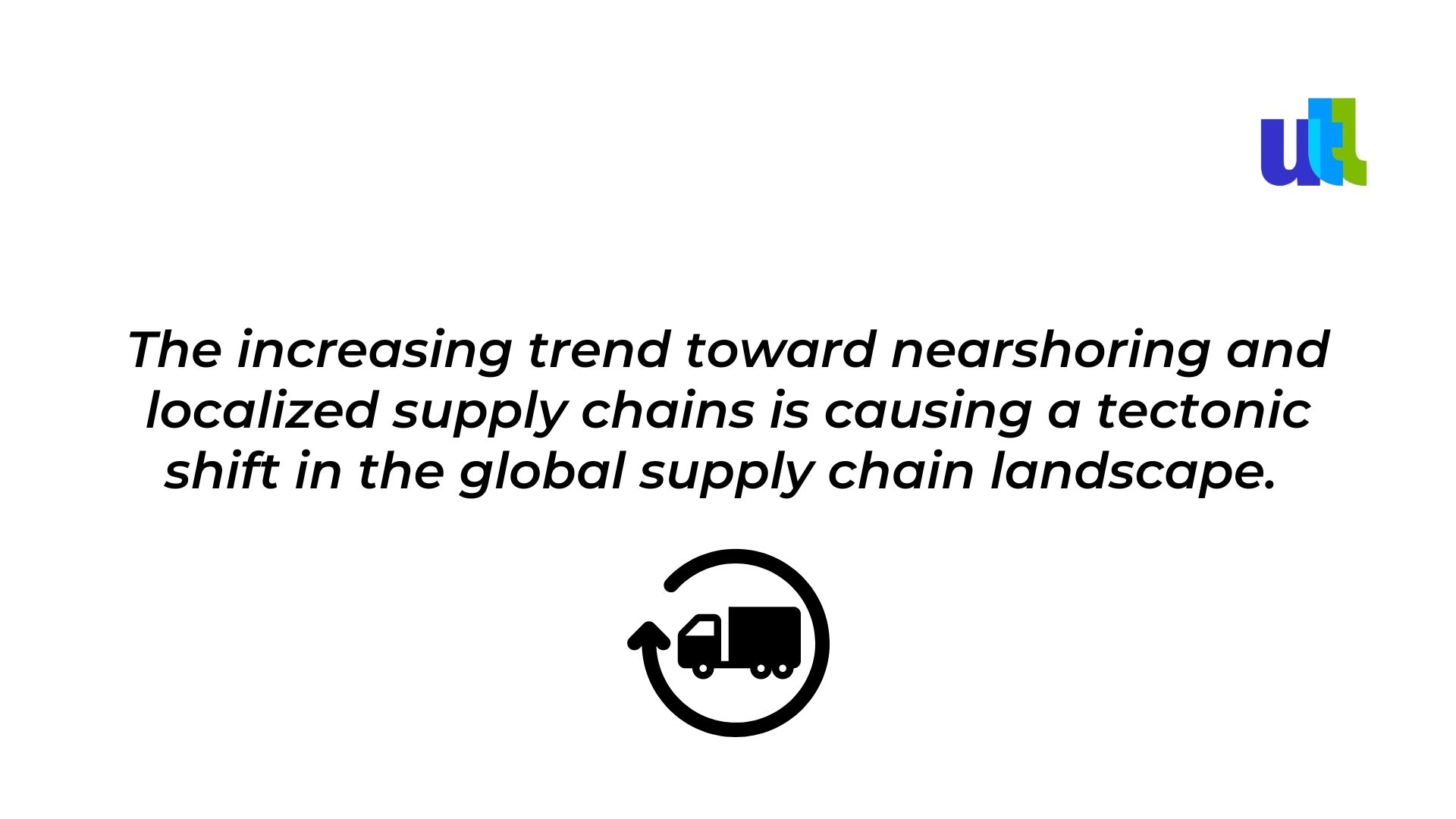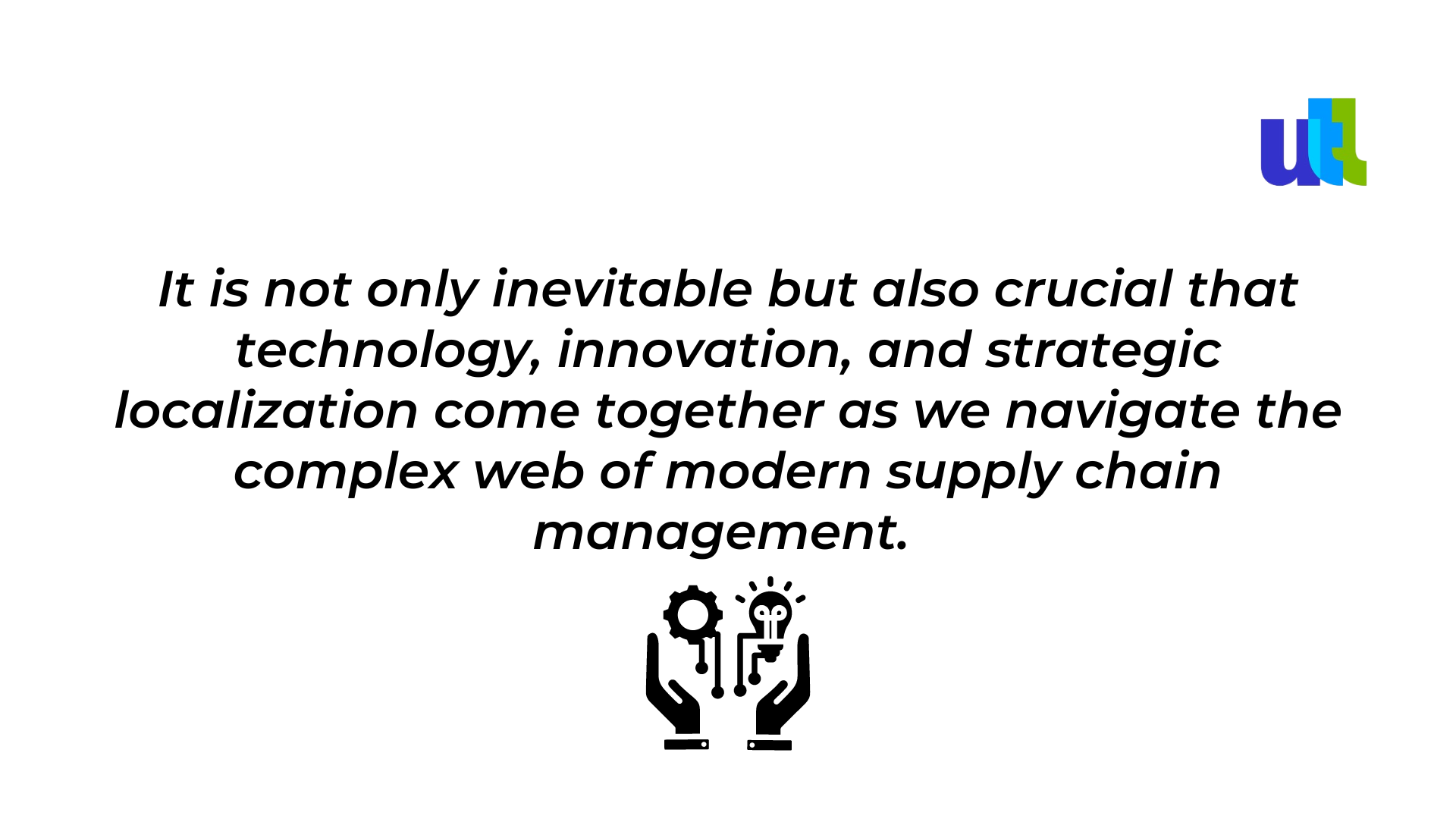The seamless operations of global supply chains, a complicated network that links producers, suppliers, and consumers across continents, have been loosening the world economy for decades. The foundation of this system has been a centralised supply chain, with an emphasis on central headquarters and extensive warehousing aimed at serving large markets from single strategic locations. But the nature of international trade is changing. Businesses are shifting more and more toward localizing their supply chains and nearshoring operations in response to increasing challenges like political unpredictability, economic pressures, and the need for quick delivery. This strategic shift intends to gain advantages of cost-effectiveness, responsiveness, and agility in addition to protecting against worldwide uncertainties.

This trend is a strategic realignment in response to the growing need for businesses to reduce the risks associated with global networks and to be closer to their customer bases. It is not just a passing trend. Relocating production and distribution closer to the final customer can greatly cut lead times and improve a company's capacity to react quickly to changes in the market. This is the essence of localizing supply chains.
As part of this strategy, nearshoring entails shifting operations from countries across the globe to nearby ones, shortening the supply chain and facilitating more seamless coordination and collaboration. This change gives businesses more operational control in addition to meeting customer demands for quicker delivery times. It also helps them navigate the same or comparable legal and cultural environments.
The COVID-19 pandemic, which exposed the vulnerability of extended supply chains, trade wars that imposed tariffs and other barriers, and the growing emphasis on sustainability—which advocates for reducing long-distance transportation in order to reduce carbon footprints—have all contributed to this change. Businesses are realizing that localized supply chains and nearshoring can also be a competitive advantage as they adjust to this new normal. These strategies offer the flexibility to change course quickly in response to shifting market conditions, the resilience to endure local disruptions, and the agility to quickly innovate in response to local consumer preferences.
In the following sections, we will examine the many advantages and difficulties of this strategic change, as well as how it is influencing international trade.
Pros of decentralized supply chains
1. Enhanced customer reach:
Decentralized supply chains enable businesses to establish a presence closer to their customer bases. This geographic proximity allows for a more expansive market reach.
2. Quicker delivery times:
With multiple distribution centers, companies can offer expedited shipping to customers. This is critical in an era where fast delivery is often a deciding factor for customers making purchases.
3. Local presence:
Operating from several locations can lend a business the appeal of a local entity, fostering trust and a sense of community among consumers.
4. Disaster resilience:
A decentralized model is inherently less vulnerable to localized disruptions. If one node encounters issues, others can compensate, maintaining the continuity of operations.
5. Business agility:
Decentralized supply chains afford businesses the flexibility to respond to market changes, test new products regionally, and experiment with new market strategies without wide-scale risk.
Cons of decentralized supply chains
1. Higher operational costs:
Running multiple facilities can significantly increase operational expenses, including costs associated with staffing, utilities, insurance, and property leases.
2. Risk of inefficiency:
With resources scattered across several locations, there's a potential for inefficiencies in inventory management, leading to misallocated stock and redundancy.
3. Complexity in management:
The decentralized approach can complicate oversight and coordination, demanding more robust systems for communication and control to prevent disarray.
Centralized vs. decentralized supply chains: Making the choice
Deciding between centralized and decentralized supply chains depends on the specific needs and strategic priorities of a business. While a centralized system may offer cost efficiency and control, a decentralized network provides resilience and flexibility.

For companies looking to future-proof their operations, investing in a decentralized structure could be a step towards greater long-term stability and responsiveness to market demands.
Enhancing supply chain agility through nearshoring strategies
In the intricate dance of global commerce, where every step counts, businesses are increasingly turning towards nearshoring as a strategic move to fine-tune their supply chains. Nearshoring, the practice of transferring business operations to neighboring countries closer to one's own market, stands in contrast to offshoring, which involves moving operations to distant locales to capitalize on lower labor costs. This strategy is not just about cost-cutting; it's a multifaceted approach to sharpen efficiency, bolster customer relationships, and streamline communication.
Unlike outsourcing, which leverages third-party providers often in far-flung regions, nearshoring brings production activities to the doorstep of input sources or customer bases, enhancing the responsiveness of supply chains and fostering stronger customer service ties. It’s a delicate balance between the cost-effectiveness of outsourcing and the control and quality assurance that onshoring provides. Businesses are increasingly attracted to nearshoring for its potential to reduce costs without the trade-offs of extended distance and time, allowing for greater oversight and a firmer grip over operational quality.
The advantages of nearshoring extend into the realm of operational visibility and communication—crucial elements in today’s swift-paced market environment. By situating manufacturing processes in closer proximity, companies can ensure more frequent site visits, tighter intellectual property control, and fewer cultural and language barriers. The geographical closeness also means sharing similar time zones, which streamlines real-time communication and collaboration, ultimately leading to a more agile and adaptable supply chain.
Moreover, nearshoring can drastically cut down the transit time of goods to the market, facilitating quicker delivery to customers, reducing customs and duty expenses, and bolstering the entire supply chain's efficiency. With such strategic realignment, businesses are not just responding to the challenges of globalization but are actively shaping a new, more resilient model of international trade that values speed, quality, and adaptability. This comprehensive approach to supply chain management allows companies to maintain competitiveness and innovation in a rapidly evolving global marketplace.
Creating the future

Supply chains are undergoing a digital transformation driven by blockchain, IoT, and AI that is bringing them into a new era of accountability and efficiency. These innovations have the potential to bring about supply chains that are more resilient, transparent, and responsive as they develop further.
Supply chains in the future will likely be more integrated and sensitive to the moral and sustainable standards that our global society is coming to expect. The way we think about the flow of goods and services is going to drastically change over the next ten years, with sustainability and ethics taking the lead.
Conclusion
In conclusion, the move toward nearshoring and localized supply chains is a calculated response to the changing nature of the economy. Such a shift has many advantages, including better customer relations, lower expenses, and increased control. However, they are accompanied by difficulties that require our attention, like the requirement for infrastructure development and the difficulty of administering dispersed networks. In the midst of these changes, it is critical to emphasize the value of flexibility and strategic planning.
Call to action
It is critical that supply chain experts, business executives, and legislators consider how these trends will affect their industries and the market as a whole as we stand at this crossroads.
For free consultation on supply chains in the modern marketplace, click here.
----------------------------------------------------------------------------------------------
View the full presentation:
WRITTEN BY
Milda Butkeviciute
2023-12-15














































































































































































